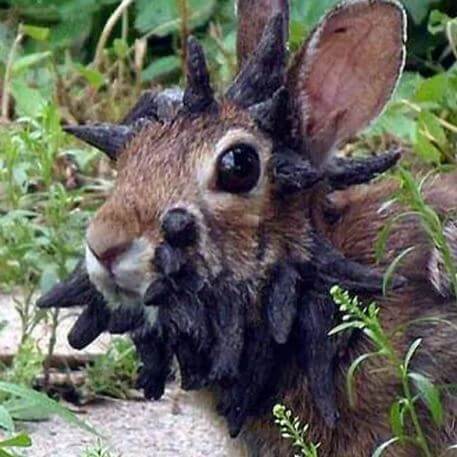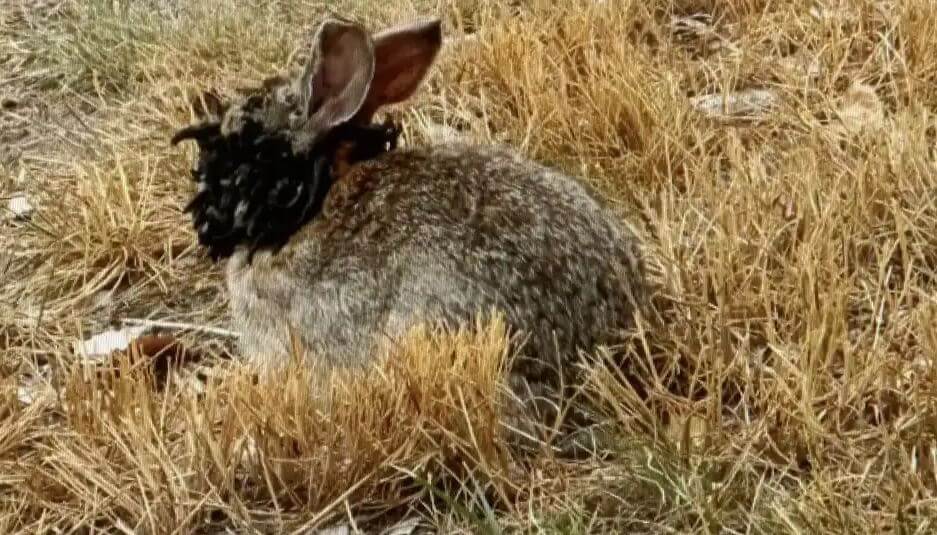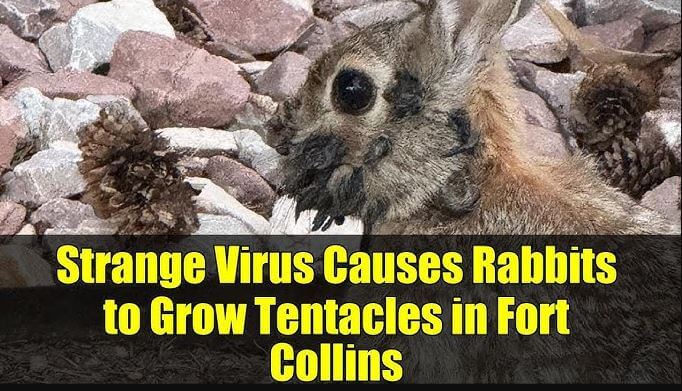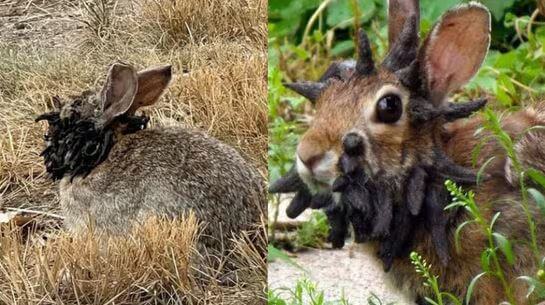Contents
- 1 The Enigma of “Tentacled Rabbits”: Unraveling the Science, Folklore, and Viral Phenomenon
- 2 II. The Science Behind the Sightings: Shope Papillomavirus (CRPV)
- 3 III. Impact and Public Health Considerations
- 4 IV. Cultural Context: From Folklore to Internet Sensation
- 5 V. Conclusion: Separating Fact from Fiction
The Enigma of “Tentacled Rabbits”: Unraveling the Science, Folklore, and Viral Phenomenon
I. Introduction: The Viral Phenomenon of “Tentacled Rabbits”

Recent weeks have seen a surge of public attention surrounding alarming sightings of wild rabbits exhibiting unusual growths, a phenomenon that has rapidly gone viral across major social media platforms, including TikTok and YouTube, since early August 2025. Residents, particularly in areas such as Fort Collins, Colorado, have reported encountering these strikingly altered animals, often describing them as “demon rabbits” due to the black, horn- or tentacle-like protrusions emanating from their heads and faces. These reports have ignited widespread online discussion and extensive media coverage, reflecting a collective fascination with the bizarre in nature. The visual impact of these images and videos has been profound, with public descriptions ranging from “black quills” and “black toothpicks” to “scabbiesh-looking growths” jutting from the animals’ faces and mouths, fueling both curiosity and, in some instances, considerable alarm.
Despite the popular and visually descriptive term “rabbits with tentacles” widely adopted in public discourse, it is crucial to clarify from the outset that the growths observed on these animals are not biological tentacles in the scientific, zoological sense. The widespread adoption of such a visually striking but biologically inaccurate term highlights how a compelling visual misnomer can rapidly gain traction, especially when amplified by the instantaneous and pervasive nature of social media’s image and video sharing capabilities. This rapid dissemination of a catchy, albeit imprecise, descriptor underscores that the current public interest extends beyond the mere biological reality of the condition; it encompasses the social amplification of a visually impactful phenomenon.
From a biological perspective, true tentacles are defined as flexible, mobile, and elongated organs predominantly found in invertebrate species, such as octopuses, squids, and jellyfish. These specialized structures serve a variety of vital functions, including sensory perception, defense, locomotion, and the capture of food, operating primarily as muscular hydrostats. The immediate public reaction to describing the growths as “tentacle-like,” rather than employing a more clinical or scientific descriptor, suggests an inherent human inclination to interpret unusual or unfamiliar biological phenomena through the lens of familiar, often fantastical, imagery. This psychological or cultural predisposition sets a crucial foundation for understanding how such natural occurrences become interwoven with folklore and popular narratives, as will be explored later in this report.
To provide a clear distinction between the popular perception and scientific reality, the following table outlines the fundamental differences between true biological tentacles and the growths observed on these rabbits.
This report will systematically delve into the scientific reality behind these appearances, meticulously distinguishing them from genuine biological tentacles, and exploring the fascinating interplay between scientific fact and cultural interpretation.
II. The Science Behind the Sightings: Shope Papillomavirus (CRPV)

The grotesque and alarming growths observed on these rabbits are, in scientific reality, caused by a specific viral agent known as the Cottontail Papilloma Virus (CRPV). This virus is also commonly referred to as Shope papilloma virus (SPV). CRPV is classified as a DNA virus, and its presence and effects were first documented and identified as early as the 1930s, indicating a long history of scientific study. The fact that this virus has been known for nearly a century challenges the perception, sometimes conveyed in social media, that this is a “suddenly dramatic return” or a new phenomenon; rather, it is a well-documented condition that has recently gained renewed public visibility.
Significantly, CRPV has been extensively utilized in scientific research as a model for studying both cancer development and the broader mechanisms of papillomaviruses. This application underscores its importance beyond a mere wildlife affliction, contributing valuable insights into general viral pathologies and oncogenesis. The study of CRPV can, for instance, provide deeper understanding of how certain viruses trigger uncontrolled cell growth, a process central to various human cancers, including those associated with human papillomaviruses (HPV). This connection elevates the scientific significance of this seemingly isolated wildlife virus, implying that studying its mechanisms and pathology can contribute to a broader understanding and potentially new therapeutic strategies for human diseases.
Pathology of the “Tentacle-like” Growths: How they Form and Why they Appear as they Do
The viral infection primarily targets and affects the epithelial cells of the rabbit’s skin, triggering an abnormal and uncontrolled proliferation of these cells. Over a period of time, these rapidly growing tumors undergo a process of hardening, transforming into dense, keratinized structures that bear a resemblance to warts. The resulting manifestations are typically hard, black projections that can assume various forms, often described as horns, spikes, or, as observed by the public and media, “tentacles”. This pathological description is fundamentally distinct from the biological definition of a true tentacle, which is a functional, specialized, and often muscular organ. The visual resemblance, while striking, is purely superficial. The underlying biological process is one of uncontrolled, diseased cell growth, not the development of a complex, evolved organ. This precise distinction is paramount for maintaining scientific accuracy.
These growths are most frequently observed developing around the rabbit’s head and facial region, particularly near sensitive areas such as the mouth, nose, and eyes. They can sometimes appear in dense clusters, creating the highly striking and often alarming appearance that has garnered recent public attention. One resident noted seeing an infected rabbit for two consecutive years, with the growth enlarging over time, indicating the chronic nature of the condition for the affected animal.
Transmission and Geographic Distribution of the Virus
The primary mode of transmission for CRPV is through the bites of infected arthropod vectors, specifically biting insects like mosquitoes and ticks. These insects acquire the virus by feeding on an infected rabbit and subsequently transmit the viral DNA to uninfected animals. Direct contact between rabbits can also facilitate the spread of the virus, though vector transmission is considered a significant pathway. The documented transmission pathway via biting insects and the observed higher prevalence of outbreaks during warmer months strongly indicate that environmental conditions and the dynamics of vector populations play a crucial role in the virus’s epidemiology. This suggests that shifts in climate patterns or changes in insect habitats and populations could directly influence the future frequency, intensity, and geographic range of these sightings, thereby linking the phenomenon to broader ecological and environmental health considerations.
While the most recent wave of public sightings has been concentrated in specific locales, such as Fort Collins, Colorado, it is important to note that documented cases of similar CRPV infections have been recorded in various other regions across North America, indicating a broader geographic prevalence.
For a concise overview of the scientific aspects of this condition, refer to the table below:
Table 1: Key Facts about Shope Papillomavirus (CRPV)
III. Impact and Public Health Considerations
Effects of CRPV on Infected Rabbits: Health, Survival, and Potential Complications

While the Shope papillomavirus is generally not directly lethal to infected rabbits, the presence and nature of the growths can severely compromise an affected animal’s ability to survive and thrive in its natural wild environment. Large or strategically located tumors can significantly impair critical senses and functions. They may limit the rabbit’s eyesight, making it difficult to navigate or detect predators; hamper food intake, leading to malnutrition; affect their sense of smell, crucial for foraging and detecting threats; or reduce their overall vigilance against predators, thereby increasing their vulnerability. This emphasis on the severe detrimental impact of CRPV on the rabbit’s quality of life and its ability to survive in the wild effectively shifts the narrative’s focus towards critical animal welfare and broader ecological considerations, extending beyond immediate human concerns.
In a small percentage of cases, there exists a possibility that these wart-like growths may undergo malignant transformation and become cancerous, though this is not the most common outcome of the infection. Observations from residents indicate that these growths can enlarge over time, suggesting that the infection can be a chronic and progressively debilitating condition for the individual rabbit. It is important to note that the condition is not widespread across the entire rabbit population, as most rabbits possess or develop an immune response capable of dealing with the virus and mitigating severe growth development.
Addressing Human and Pet Safety: Clarifying Non-Transmissibility
A critical public health message, consistently reinforced by authorities such as Colorado Parks and Wildlife (CPW) and other wildlife officials, is that the Shope papillomavirus is highly rabbit-specific. It is unequivocally confirmed that the virus is not harmful or transmissible to humans, domestic dogs, cats, or other wildlife species. Despite initial public concern and the sensationalized narratives that may circulate on social media, there is no scientific evidence whatsoever to suggest that direct contact with infected rabbits poses a public health threat to humans. The presence of both sensationalized social media content (e.g., “RED ALERT Mutant rabbits” in ) and authoritative, reassuring statements from wildlife officials highlights a dual challenge in public health communication: not only dispelling unfounded fears but also simultaneously promoting responsible and ethical behavior. The statement that there is “no known cure” for the virus in wild populations could potentially incite alarm, but it is strategically balanced by the clear “not dangerous to humans” and “leave them alone” advice, demonstrating a careful approach to public messaging.
Official Guidance for Public Interaction with Infected Wildlife
Wildlife officials strongly advise members of the public to maintain a respectful distance and avoid approaching, touching, feeding, or attempting to “help” wild rabbits exhibiting these growths. This recommendation is primarily aimed at preventing unnecessary stress or injury to the already compromised animals and to avoid potential bites from a wild animal, rather than due to a risk of human health transmission. The advice to “leave them alone” is not solely for human safety but crucially aims to minimize additional stress and potential harm to already compromised wild animals, highlighting a more nuanced approach to wildlife management.
Pet owners are specifically advised to keep their domestic dogs and cats away from wild rabbits to prevent any potential interactions, even though the virus itself is not transmissible to companion animals. Any sightings of rabbits with unusual growths should be promptly reported to local wildlife authorities, as these agencies are actively monitoring the spread and severity of the condition within wild populations.
For domestic rabbits, where direct veterinary care is feasible, surgical removal of the growths can be considered as a treatment option. Furthermore, prevention through diligent insect control is highlighted as a key strategy to reduce infection risk in captive animals. However, for wild rabbits, the prevailing expert advice is to “simply leave them alone and allow nature to take its course,” acknowledging the impracticality and potential harm of intervention in a wild setting. This clear distinction in recommended approaches – surgical treatment and insect control for domestic rabbits versus a “leave alone and let nature take its course” philosophy for wild rabbits – vividly illustrates the practical challenges and underlying ethical frameworks of wildlife disease management. For an endemic, non-human-transmissible virus in wild populations, widespread direct intervention is often deemed impractical, potentially more harmful to the animals, or simply not a sustainable or necessary public health measure.
IV. Cultural Context: From Folklore to Internet Sensation
The Jackalope Legend: Exploring the Historical Link between CRPV-infected Rabbits and the Mythical Creature

The strikingly unusual appearance of rabbits afflicted with the Shope papillomavirus is widely accepted as a compelling inspiration for the enduring American legend of the jackalope. The jackalope is a well-known mythical creature, typically depicted as a fantastical hybrid: possessing the body of a rabbit but adorned with the antlers or horns characteristic of an antelope. This myth gained significant popularity in the Western United States during the 20th century, with its origins famously traced back to Douglas, Wyoming, in 1932. Here, the Herrick brothers, skilled taxidermists, are credited with creating the first physical “jackalopes” by affixing deer antlers onto rabbit carcasses, subsequently selling these novelties to curious tourists. This historical account demonstrates a long-standing human tendency to interpret unusual natural phenomena through the lens of folklore and to even create physical representations of these interpretations.
Intriguingly, the concept of horned rabbits extends beyond American folklore, with historical and international parallels found in medieval literature (e.g., 17th-century Historiae Naturalis de Quadrupetibus Libri, 16th-century Animalia Qvadrvpedia et Reptilia) and German folklore (e.g., the wolpertinger, a hare with deer antlers; the rasselbock, a rabbit with deer antlers). These widespread depictions suggest a long-standing human fascination with such chimerical creatures, indicating a universal pattern of responding to the bizarre in nature by weaving it into mythical narratives. The recent surge in sightings in Colorado has notably reignited public interest in this historical connection, serving as a contemporary example of how real biological phenomena can powerfully fuel and perpetuate enduring cultural myths and legends. The compelling historical and folkloric link between CRPV-infected rabbits and the jackalope legend, combined with the recent viral “tentacled rabbit” trend, collectively illustrate a consistent and deep-seated human pattern: when confronted with visually unusual, bizarre, or even grotesque natural phenomena, people often instinctively interpret these occurrences through the lens of existing folklore, myth, or resort to sensationalized narratives.
The “Rabbits with Tentacles” Trend: How Social Media Amplifies Unusual Natural Phenomena
The current “rabbits with tentacles” phenomenon represents a modern iteration of humanity’s inherent fascination with unusual animal appearances. This recent trend has been dramatically amplified by the unprecedented speed, reach, and visual nature of contemporary social media platforms. Unlike the jackalope, which boasts a deeply rooted and long-established presence in folklore and fictional narratives, the specific concept of “tentacled rabbits” appears to be a more recent, visually-driven interpretation directly stemming from the viral images and videos of CRPV-infected rabbits circulating online. While fictional works feature cats with tentacles or rabbits with other unusual traits (humanoid, speaking, horns), the explicit “rabbits with tentacles” as a common, pre-existing trope is not widely documented in popular culture prior to these recent viral sightings.
Social media platforms enable the rapid and widespread dissemination of images and videos, which, while raising public awareness, can also inadvertently lead to sensationalized or exaggerated narratives (e.g., “RED ALERT Mutant rabbits with black TENTACLES are infesting Colorado”) alongside more factual reporting. This phenomenon vividly highlights the dual nature of online information: it is a powerful tool for rapidly raising awareness about natural occurrences but simultaneously serves as a fertile ground for the proliferation of misinformation, exaggerated claims, and unnecessary alarm. The jackalope myth’s origins trace back to physical taxidermy pranks and sightings of diseased animals, with its dissemination primarily occurring through oral tradition, local storytelling, and early forms of media. In contrast, the “tentacled rabbit” phenomenon, while rooted in the same underlying biological cause, has exploded into public consciousness almost entirely through viral videos and widespread social media sharing. This stark difference demonstrates a clear and significant evolution in how “myths” (or at least popular misinterpretations and trends) are created, propagated, and consumed in the modern era, underscoring the unprecedented speed, reach, and visual dominance of digital platforms compared to traditional methods of folklore dissemination.
Furthermore, the social media narrative that the virus is “suddenly making a dramatic return” directly contradicts the scientific understanding that the virus is “relatively common” in wild rabbit populations. This discrepancy highlights a crucial point: public perception, often driven by the novelty of visual content and the algorithms of social media, can inadvertently create a sense of urgency, uniqueness, or crisis around natural phenomena that are, from a scientific standpoint, well-documented and long-standing. This underscores the challenge of communicating nuanced scientific reality in a fast-paced, visually-driven information environment.
V. Conclusion: Separating Fact from Fiction
The trending phenomenon of “rabbits with tentacles” refers to wild rabbits afflicted by the Shope papillomavirus (CRPV). This virus causes the development of hardened, keratinized tumorous growths, which, despite their appearance, are not true biological tentacles in the zoological sense. Scientifically, CRPV is a DNA virus that has been recognized since the 1930s and holds significant importance as a model in ongoing cancer and papillomavirus research. This long history of scientific study and its utility as a research model underscore that this is a known biological entity, not a novel mutation or threat.
While these growths can severely impair an infected rabbit’s ability to survive in the wild by compromising essential functions like vision, eating, and evasion from predators, it is crucial to reiterate that the virus is not transmissible to humans, domestic pets (dogs or cats), or other wildlife species. For the public, the consistent and authoritative advice from wildlife officials is to observe these animals from a respectful distance, avoid any attempts at physical contact or feeding, and report any sightings to local wildlife authorities for monitoring purposes. This approach prioritizes both human safety and animal welfare, minimizing stress to the afflicted wildlife.
The case of the “tentacled rabbits” serves as a compelling and contemporary example of how complex natural biological phenomena can intricately intersect with human curiosity, deeply ingrained folklore, and the rapid, pervasive dissemination of information characteristic of the digital age. The entire discussion has meticulously detailed the rapid and often unfiltered spread of information, encompassing both scientifically accurate facts and sensationalized, misleading narratives. This phenomenon powerfully underscores the critical importance of relying on authoritative scientific sources and expert interpretations to accurately distinguish between visually striking appearances and their underlying biological realities, particularly in an era where viral content can quickly shape public perception.
The specific case of “rabbits with tentacles,” with its unique blend of virology, animal welfare, public health, historical folklore, and modern social media trends, offers an exceptional opportunity for public education. By thoroughly explaining the scientific basis of the virus, its impact on the animals, the origins of the associated myth, and the dynamics of its viral spread, this report contributes to a broader public understanding of how scientific inquiry and knowledge empower individuals to interpret and make sense of the world around them, even its most bizarre and seemingly inexplicable manifestations. Ultimately, a comprehensive understanding of the science behind such occurrences empowers the public to respond in an informed and rational manner, effectively dispelling unnecessary fear, countering misinformation, and fostering a more balanced and nuanced appreciation for the intricate complexities of wildlife health and the broader dynamics of natural ecosystems. This reinforces the fundamental responsibility of providing clear, factual, and authoritative information to counter the pervasive influence of misinformation in the digital age.
